Abstract
The antigenic heterogeneity of angiotensin II (AII) was studied with monoclonal antibodies. Twelve antibodies were produced and characterized. Association constants for AII varied from 1.2 X 10(8) to 1.1 X 10(10) M-1. The fine specificity of the Mab was studied by immunoenzymoassay using solid-phase AII. Using AII analogues in binding inhibition experiments, three groups of specificity could be characterized: (1) five antibodies reacted only with peptides in which phenylalanine is the carboxy terminal aminoacid; for two of these antibodies, tyrosine4 is closely associated with the binding site, since iodine labelling suppresses reactivity; (2) two antibodies also required phenylalanine in position 8, but, in addition, reacted with AI, a decapeptide in which phenylalanine is not terminal; (3) five antibodies reacted with analogues in which phenylalanine had been substituted for another amino acid. In addition, studies in which binding of a biotinylated Mab to solid-phase AII was analysed in the presence of various unlabelled Mab suggest further antigenic heterogeneity of AII.
Full text
PDF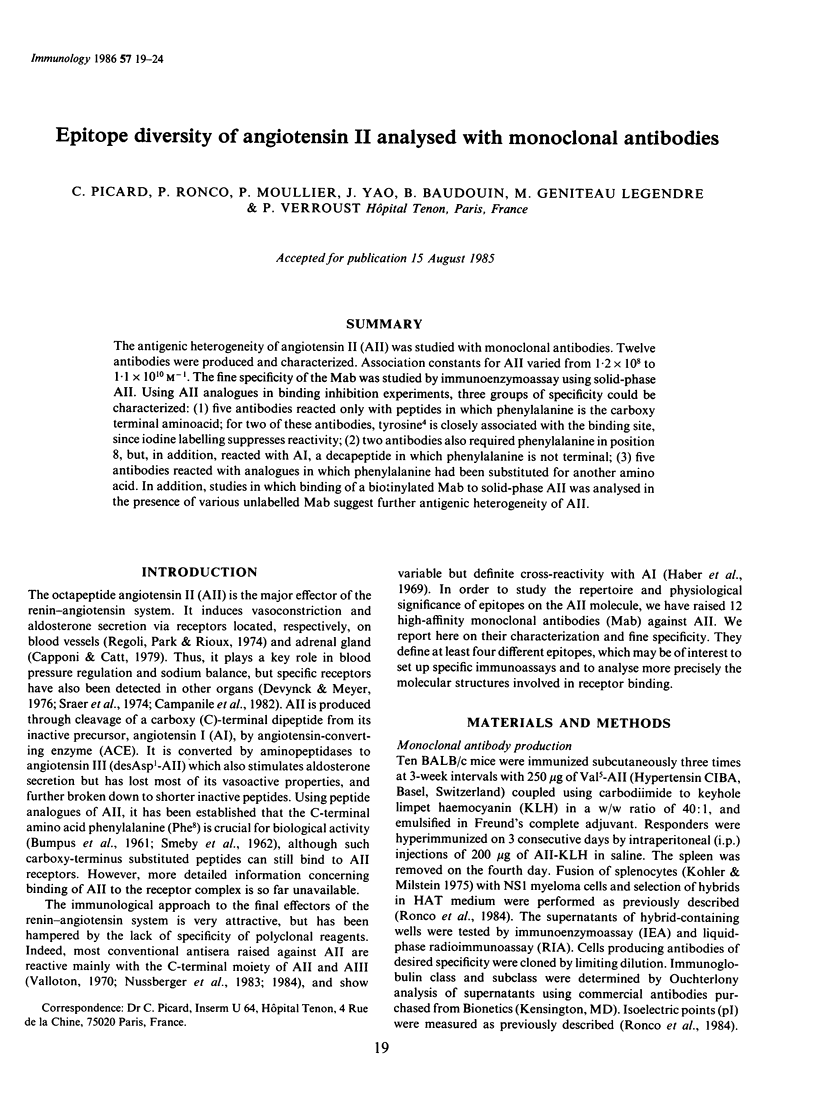

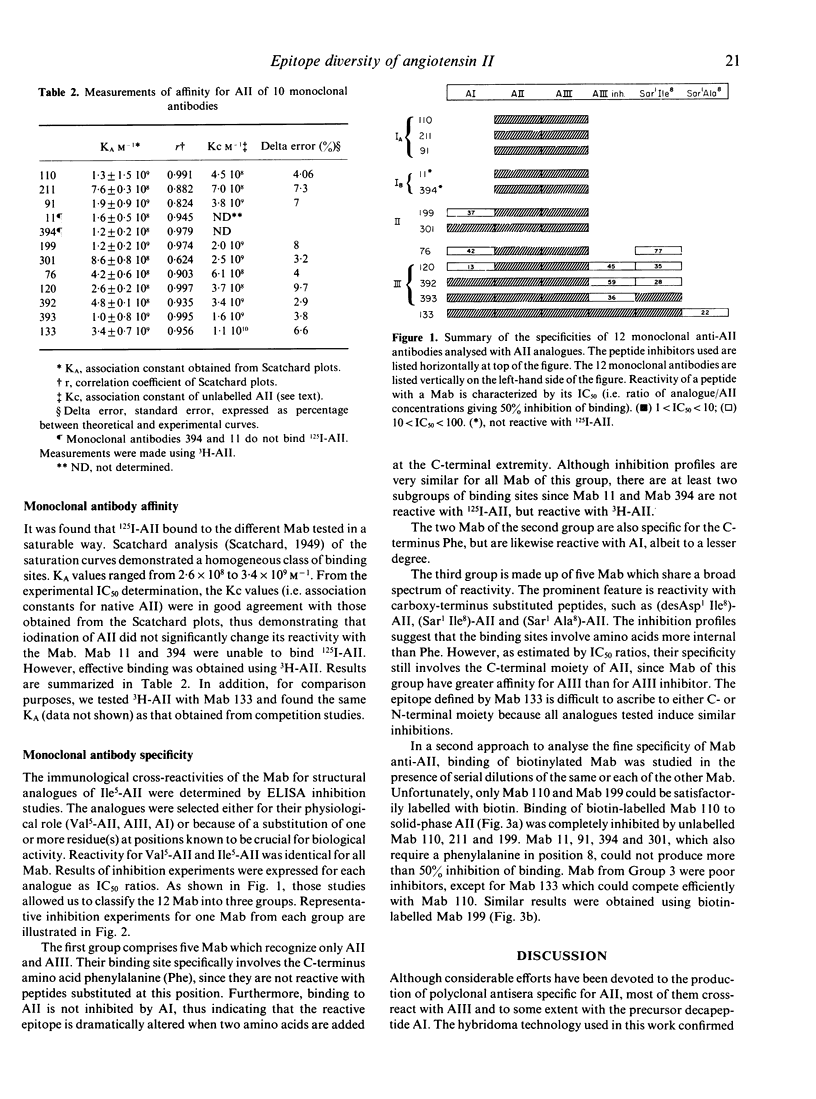
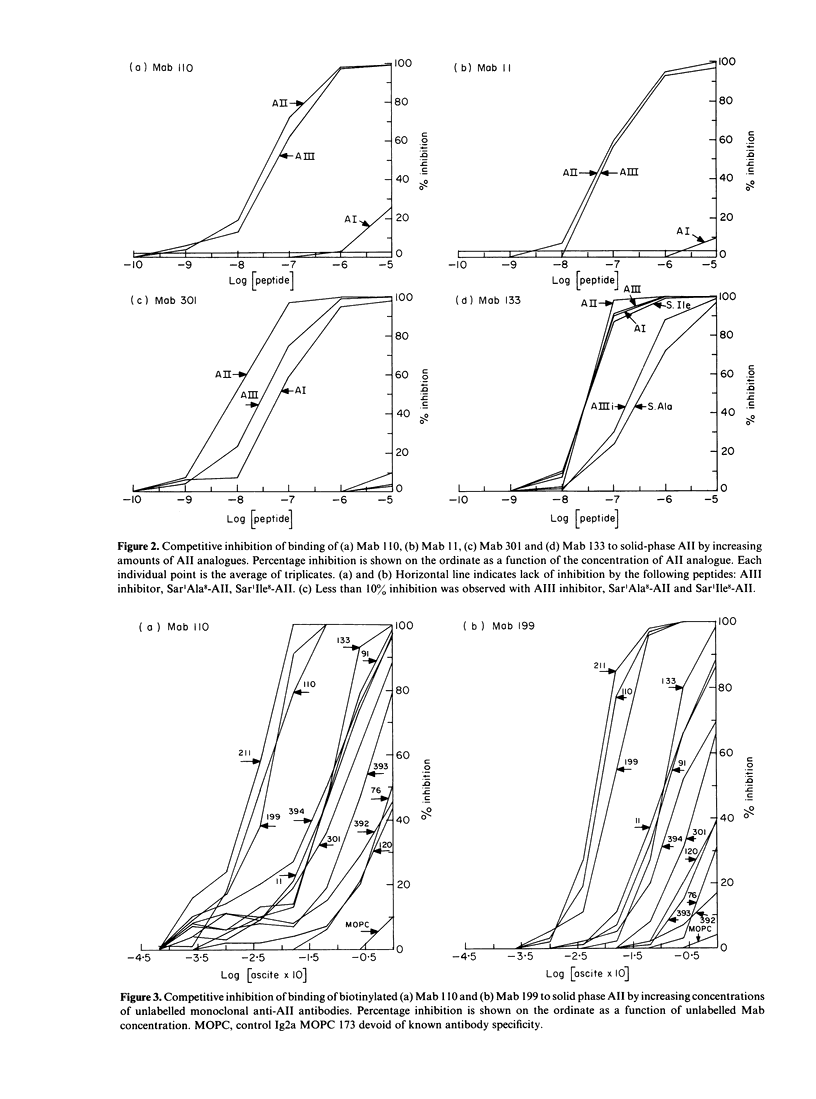
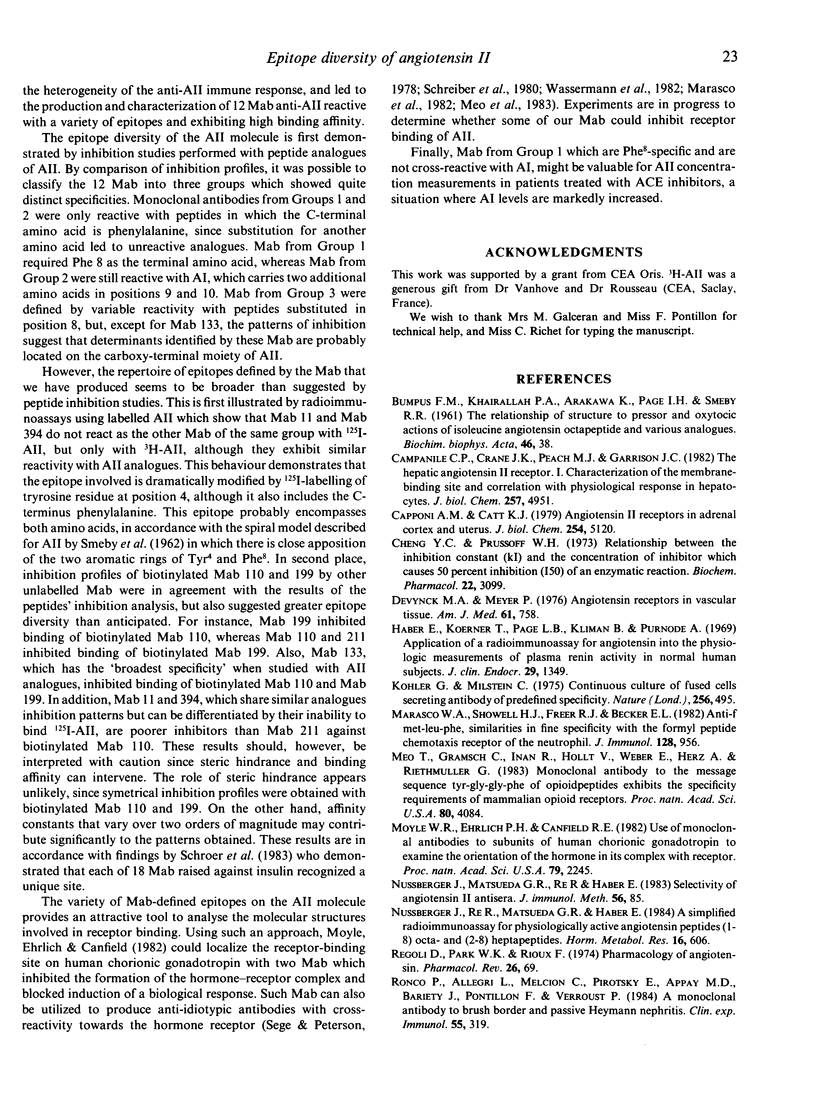
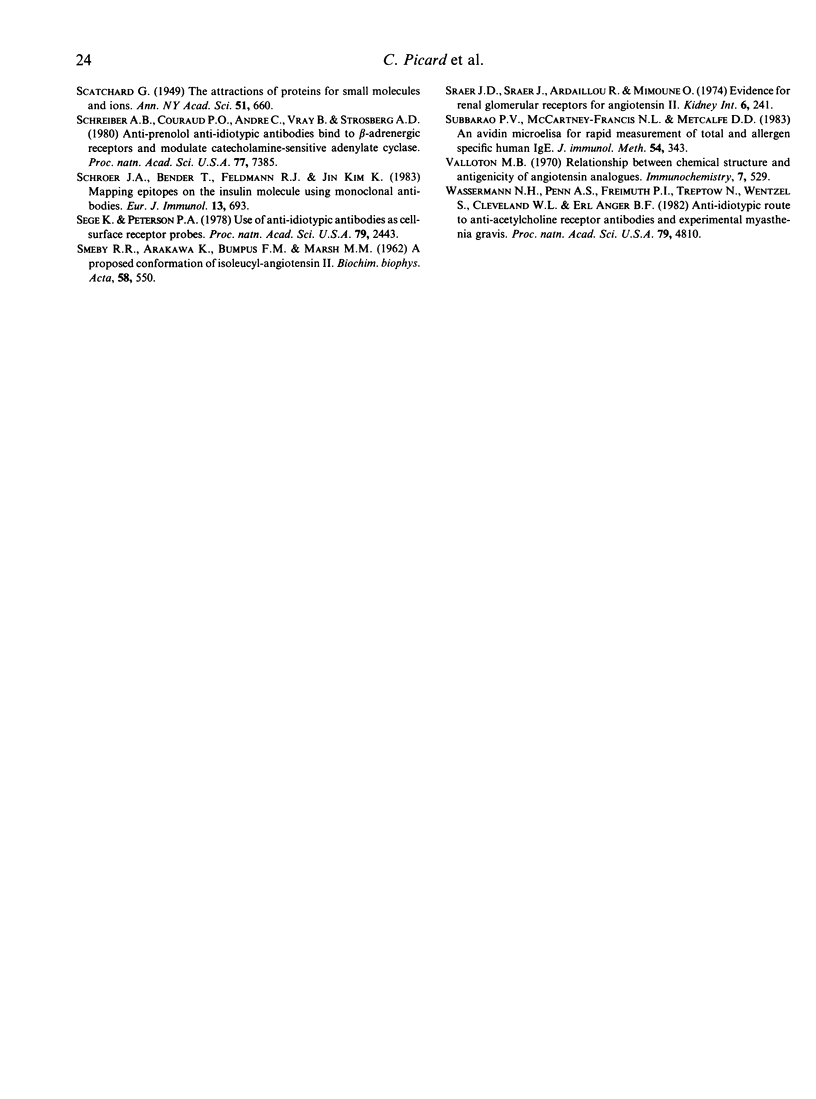
Selected References
These references are in PubMed. This may not be the complete list of references from this article.
- Campanile C. P., Crane J. K., Peach M. J., Garrison J. C. The hepatic angiotensin II receptor. I. Characterization of the membrane-binding site and correlation with physiological response in hepatocytes. J Biol Chem. 1982 May 10;257(9):4951–4958. [PubMed] [Google Scholar]
- Capponi A. M., Catt K. J. Angiotensin II receptors in adrenal cortex and uterus. Binding and activation properties of angiotensin analogues. J Biol Chem. 1979 Jun 25;254(12):5120–5127. [PubMed] [Google Scholar]
- Cheng Y., Prusoff W. H. Relationship between the inhibition constant (K1) and the concentration of inhibitor which causes 50 per cent inhibition (I50) of an enzymatic reaction. Biochem Pharmacol. 1973 Dec 1;22(23):3099–3108. doi: 10.1016/0006-2952(73)90196-2. [DOI] [PubMed] [Google Scholar]
- Devynck M. A., Meyer P. Angiotensin receptors in vascular tissue. Am J Med. 1976 Nov;61(5):758–767. doi: 10.1016/0002-9343(76)90157-1. [DOI] [PubMed] [Google Scholar]
- Haber E., Koerner T., Page L. B., Kliman B., Purnode A. Application of a radioimmunoassay for angiotensin I to the physiologic measurements of plasma renin activity in normal human subjects. J Clin Endocrinol Metab. 1969 Oct;29(10):1349–1355. doi: 10.1210/jcem-29-10-1349. [DOI] [PubMed] [Google Scholar]
- Köhler G., Milstein C. Continuous cultures of fused cells secreting antibody of predefined specificity. Nature. 1975 Aug 7;256(5517):495–497. doi: 10.1038/256495a0. [DOI] [PubMed] [Google Scholar]
- Marasco W. A., Showell H. J., Freer R. J., Becker E. L. Anti-f Met-Leu-Phe: similarities in fine specificity with the formyl peptide chemotaxis receptor of the neutrophil. J Immunol. 1982 Feb;128(2):956–962. [PubMed] [Google Scholar]
- Meo T., Gramsch C., Inan R., Höllt V., Weber E., Herz A., Riethmüller G. Monoclonal antibody to the message sequence Tyr-Gly-Gly-Phe of opioid peptides exhibits the specificity requirements of mammalian opioid receptors. Proc Natl Acad Sci U S A. 1983 Jul;80(13):4084–4088. doi: 10.1073/pnas.80.13.4084. [DOI] [PMC free article] [PubMed] [Google Scholar]
- Moyle W. R., Ehrlich P. H., Canfield R. E. Use of monoclonal antibodies to subunits of human chorionic gonadotropin to examine the orientation of the hormone in its complex with receptor. Proc Natl Acad Sci U S A. 1982 Apr;79(7):2245–2249. doi: 10.1073/pnas.79.7.2245. [DOI] [PMC free article] [PubMed] [Google Scholar]
- Nussberger J., Matsueda G. R., Re R., Haber E. Selectivity of angiotensin II antisera. J Immunol Methods. 1983;56(1):85–96. doi: 10.1016/0022-1759(83)90051-0. [DOI] [PubMed] [Google Scholar]
- Nussberger J., Re R., Matsueda G. R., Haber E. A simplified radioimmunoassay for physiologically active angiotensin peptides [(1-8) octa- and (2-8) heptapeptides]. Horm Metab Res. 1984 Nov;16(11):606–610. doi: 10.1055/s-2007-1014862. [DOI] [PubMed] [Google Scholar]
- Regoli D., Park W. K., Rioux F. Pharmacology of angiotensin. Pharmacol Rev. 1974 Jun;26(2):69–123. [PubMed] [Google Scholar]
- Ronco P., Allegri L., Melcion C., Pirotsky E., Appay M. D., Bariety J., Pontillon F., Verroust P. A monoclonal antibody to brush border and passive Heymann nephritis. Clin Exp Immunol. 1984 Feb;55(2):319–332. [PMC free article] [PubMed] [Google Scholar]
- SMEBY R. R., ARAKAWA K., BUMPUS F. M., MARSH M. M. A proposed conformation of isoleucyl-5-angiotensin II. Biochim Biophys Acta. 1962 Apr 23;58:550–557. doi: 10.1016/0006-3002(62)90065-3. [DOI] [PubMed] [Google Scholar]
- Schreiber A. B., Couraud P. O., Andre C., Vray B., Strosberg A. D. Anti-alprenolol anti-idiotypic antibodies bind to beta-adrenergic receptors and modulate catecholamine-sensitive adenylate cyclase. Proc Natl Acad Sci U S A. 1980 Dec;77(12):7385–7389. doi: 10.1073/pnas.77.12.7385. [DOI] [PMC free article] [PubMed] [Google Scholar]
- Schroer J. A., Bender T., Feldmann R. J., Kim K. J. Mapping epitopes on the insulin molecule using monoclonal antibodies. Eur J Immunol. 1983 Sep;13(9):693–700. doi: 10.1002/eji.1830130902. [DOI] [PubMed] [Google Scholar]
- Sege K., Peterson P. A. Use of anti-idiotypic antibodies as cell-surface receptor probes. Proc Natl Acad Sci U S A. 1978 May;75(5):2443–2447. doi: 10.1073/pnas.75.5.2443. [DOI] [PMC free article] [PubMed] [Google Scholar]
- Sraer J. D., Sraer J., Ardaillou R., Mimoune O. Evidence for renal glomerular receptors for angiotensin II. Kidney Int. 1974 Oct;6(4):241–246. doi: 10.1038/ki.1974.105. [DOI] [PubMed] [Google Scholar]
- Wassermann N. H., Penn A. S., Freimuth P. I., Treptow N., Wentzel S., Cleveland W. L., Erlanger B. F. Anti-idiotypic route to anti-acetylcholine receptor antibodies and experimental myasthenia gravis. Proc Natl Acad Sci U S A. 1982 Aug;79(15):4810–4814. doi: 10.1073/pnas.79.15.4810. [DOI] [PMC free article] [PubMed] [Google Scholar]


